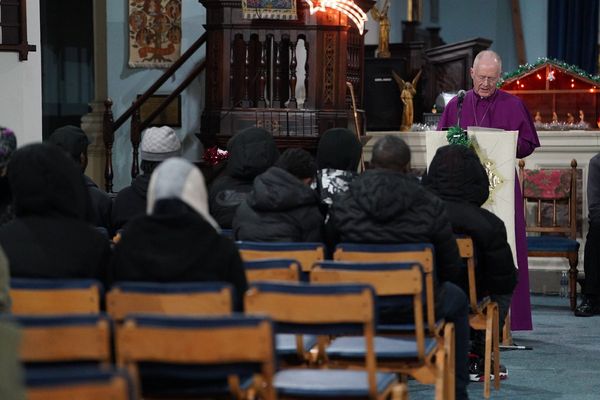
The S&P 500 is poised to rebound firmly from yesterday's brutal selloff, a top Wall Street analyst predicated Tuesday, suggesting the biggest decline in two years is an isolated event that will be offset by solid economic growth and Federal Reserve interest rate cuts.
Global markets were rocked yesterday by outsized moves in Asia that spilled over into the European and U.S. trading sessions, ultimately lopping billions in value from regional stock indexes and triggering the biggest single-day decline in more than two years for the S&P 500.
Analysts highlighted a host of issues for the selloff, including last week's decision by the Federal Reserve to hold its benchmark lending rate steady at the highest levels in two decades, even as data from the job market continued to weaken and inflation pressures slowly retreated to the central bank's 2% target.
Geopolitical tensions, as well as the ongoing reset of megacap tech stock pricing, added to the downdraft, but overnight moves in Japan suggest the most likely culprit to yesterday's slump is the impact of the so-called yen carry trade.

Olivier Douliery/Bloomberg via Getty Images
With interest rates at near zero in the world's fourth-largest economy for decades, investors were able to borrow money cheaply, convert it to U.S. dollars (by selling yen) and purchase myriad U.S. assets such as stocks and bonds and cryptocurrencies.
Carry trade unwind
With the Bank of Japan raising rates twice over the past three months after holding them unchanged for 17 years, that trade began to lose its attraction, triggering an unwinding that included the sale of U.S. assets and the purchase of Japanese yen.
Feeding off itself, the unwinding accelerated yesterday with a massive move higher in the yen, the biggest decline for the Nikkei 225 since 1987, and the corresponding sale of U.S. assets that were once supported by the cheap yen borrowing.
Related: Black Monday on Wall Street: 5 reasons stocks are plummeting
Tuesday's Nikkei recovery, as well as the stable trading in Treasury bond markets, has some investors betting that yesterday's slump was in fact a healthy correction to a roaring bull market that still has room to run over the final five months of the year.
The Nikkei 225 surged 10.2% in Tuesday trading, clawing back all but around 1,000 points from Monday's selloff, while benchmark 10-year Treasury note yields returned to around 3.951%, close to levels seen at the end of last week.
Goldman Sachs analyst David Kostin, in fact, argued in a note published Tuesday that the pullback could provide a good entry point for investors now that the dust has settled. He noted that corrections of around 10% from a prior peak "have been attractive buying opportunities more often than not."
With the S&P 500 now down around 8.5% from its July peak, Kostin and his team are reiterating their year-end-target for the broadest benchmark of U.S. shares of 5,600 points, a level that would suggest an 8% rally from current levels.
Buy the dip
"Our forecast assumes the US economy continues to expand, earnings rise by 8% in 2024 and 6% in 2025, and the index trades at a P/E multiple of 20 times," Kostin and his team wrote. "While the drawdown has been sharp, it has barely reached the magnitude of the market decline in a typical year."
Buried in yesterday's headline news flow was a stronger-than-expected reading for the ISM's closely tracked survey on services activity last month, the biggest driver of U.S. growth prospects.
The 51.4 point reading, which is well above the 50-point marker that separates growth from contraction, included "generally positive commentary on business activity" and expanding new orders.
Solid growth
The Atlanta Fed's GDPNow forecasting tool, which was updated Tuesday, indicates a current-quarter growth rate of 2.9%, following on from a second quarter estimate of 2.8% from the Commerce Department.
The second quarter earnings season, meanwhile, has topped Wall Street forecasts, with collective profits for the S&P 500 expected to rise 12.1% from a year earlier to a share-weighted $504.1 billion.
Full-year earnings growth is forecast at 10.7%, according to LSEG data, with a 14.7% expansion penciled in for 2025.
"Worries over tech valuations and the rapid unwind of yen-funded trades are hurting global stocks," BlackRock strategists wrote in their most-recent weekly update. "We believe risk assets could recover as recession fears are alleviated and remain overweight U.S. equities, driven by the AI mega force, and Japanese stocks."
Markets are also betting big on a 50 basis point rate cut for September, with the odds now pegged at 80.5% by CME Group's FedWatch, with traders also penciling in similar-sized cuts over the final two meetings of the year in November and December.
Related: Jobs report triggers key recession warning signal as stocks plunge
"Our take on Fed easing is less aggressive than market pricing," said Seema Shah, chief global strategist at Principal Asset Management. "While the weakness of the July jobs report and market sentiment advocates for adding another rate cut to the mix, the Fed would need to see additional evidence of elevated recession risk before it turns to back-to-back 50-basis-point cuts."
"A sustained market recovery needs a catalyst, or likely a combination of catalysts, including stabilization of the Japanese yen, strong earnings numbers, and solid economic data releases," she added.
Investors are likely to endure a good deal of market volatility over the coming weeks, however, if they're looking to buy into the market following the recent three-day pullback.
CBOE Group's VIX index, the market's volatility benchmark, touched the highest in more than four years yesterday, and is still trading at a level that suggests big moves in the coming month.
The VIX was last marked at $33.06 in early Chicago trading, suggesting traders are anticipating daily swings of around 2.07%, or 175 points, for the S&P 500 over the next 30 days.
More Economic Analysis:
- Black Monday on Wall Street: 5 reasons stocks are plummeting
- After the Fed tipped markets over, now what?
- Jobs report triggers key recession warning signal as stocks
"Some signs that the selling pressure may be near its nadir have already begun to emerge, including extreme readings on the VIX measure of implied volatility," said LPL Financial's chief global strategist, Quincy Krosby.
"Watch for signs of a capitulating Fed, timely evidence of a growing economy, and a successful test of the 200-day moving average on the S&P 500 for signs a bottom may be in," she added.
Related: Veteran fund manager sees world of pain coming for stocks










